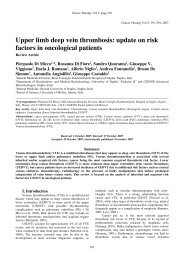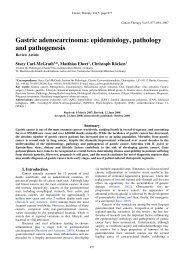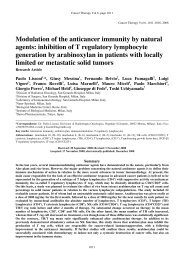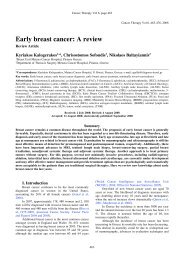Description of a case report of an intestinal-type ... - Cancer Therapy
Description of a case report of an intestinal-type ... - Cancer Therapy
Description of a case report of an intestinal-type ... - Cancer Therapy
Create successful ePaper yourself
Turn your PDF publications into a flip-book with our unique Google optimized e-Paper software.
Longo et al: <strong>Description</strong> <strong>of</strong> a <strong>case</strong> <strong>report</strong> <strong>of</strong> <strong>an</strong> <strong>intestinal</strong>-<strong>type</strong> mucinous borderline ovari<strong>an</strong> tumor<br />
<strong>of</strong> total proteins with hypoalbuminemia. The serum level <strong>of</strong> CA-<br />
125 was 120 U/ml (normal r<strong>an</strong>ge < 35 U/ml).<br />
The patient underwent surgical resection <strong>of</strong> the tumor with<br />
hysterectomy, bilateral salpingo-oophorectomy, appendectomy<br />
<strong>an</strong>d infracolic omentectomy (Figure 2A). A careful inspection <strong>of</strong><br />
the peritoneum, associated to multiple r<strong>an</strong>dom biopsies,<br />
documented the absence <strong>of</strong> peritoneal tumor impl<strong>an</strong>ts. Peritoneal<br />
cytology was negative <strong>an</strong>d no enlarged retroperitoneal lymph<br />
nodes were also detected. Histology documented <strong>an</strong> <strong>intestinal</strong><strong>type</strong><br />
MBT <strong>of</strong> the left ovary (diameter <strong>of</strong> 33x29x27cm; weight <strong>of</strong><br />
17 Kg) (Figure 2B) containing focal areas <strong>of</strong> “in situ”<br />
adenocarciroma (Figure 2C, small arrows) <strong>an</strong>d aspects <strong>of</strong> early<br />
stromal desmoplastic reaction (Figure 2C, big arrows).<br />
The postoperative course was uneventful <strong>an</strong>d the patient<br />
was discharged 10 days post-operatively. After a follow up <strong>of</strong> 19<br />
months, the patient is alive, in good clinical conditions, <strong>an</strong>d<br />
disease-free as documented by a whole body CT sc<strong>an</strong> <strong>an</strong>d serum<br />
level <strong>of</strong> CA-125 that returned to within normal r<strong>an</strong>ges.<br />
III. Discussion<br />
BOTs represent approximately 10% to 20% <strong>of</strong> all<br />
ovari<strong>an</strong> malign<strong>an</strong>cies <strong>an</strong>d c<strong>an</strong> be quite large in size,<br />
particularly mucinous histo<strong>type</strong>. In 1988, two MBOT<br />
sub<strong>type</strong>s have been described: the <strong>intestinal</strong>-<strong>type</strong> (85%)<br />
<strong>an</strong>d the endocervical-like (Mulleri<strong>an</strong>) <strong>type</strong> (15%) (Acs,<br />
2005; Hart, 2005a,b; Wong et al, 2007). MBOTs,<br />
particularly the <strong>intestinal</strong>-<strong>type</strong>, c<strong>an</strong> be associated with<br />
pseudomyxoma peritonei (10%) <strong>an</strong>d necessitates a<br />
thorough investigation <strong>of</strong> the gastro<strong>intestinal</strong> tract with<br />
special attention to the appendix (Acs, 2005; Hart, 2005a;<br />
V<strong>an</strong>g et al, 2006).<br />
The endocervical-like <strong>type</strong> is clinically <strong>an</strong>d pathologically<br />
related to serous borderline tumors with which it is <strong>of</strong>ten<br />
mixed <strong>an</strong>d it is usually associated with endometriosis<br />
(Acs, 2005; Hart, 2005a; V<strong>an</strong>g et al, 2006). The <strong>intestinal</strong><strong>type</strong><br />
is much more common <strong>an</strong>d occurs over a very wide<br />
age r<strong>an</strong>ge (9-70 years), with a me<strong>an</strong> age <strong>of</strong> 35 years (Acs,<br />
2005; Hart, 2005a,b; Wong et al, 2007). Typically, it is<br />
characterized by large multicystic masses (me<strong>an</strong> diameter,<br />
17 cm) with smooth outer surfaces like benign mucinous<br />
cystadenomas (Acs, 2005; Hart, 2005a,b; Wong et al,<br />
2007). Over 90% <strong>of</strong> these tumors are unilateral <strong>an</strong>d may<br />
have <strong>an</strong> heterogeneous composition, with coexisting areas<br />
<strong>of</strong> cystadenoma, noninvasive carcinoma, <strong>an</strong>d sometimes<br />
occult areas <strong>of</strong> invasive carcinoma. For this reason, <strong>an</strong><br />
adequate sampling is particularly import<strong>an</strong>t (Acs, 2005;<br />
Hart, 2005a,b; V<strong>an</strong>g et al, 2006; Wong et al, 2007).<br />
Figure 1. Whole body CT sc<strong>an</strong> showed a massive <strong>an</strong>d multicystic ovari<strong>an</strong> lesion (arrows) occupaying the whole abdominal (A-C) <strong>an</strong>d<br />
pelvic (D) cavity <strong>an</strong>d compressing the other intrabdominal org<strong>an</strong>s, such as liver, spleen, <strong>an</strong>d kidneys.<br />
1006







